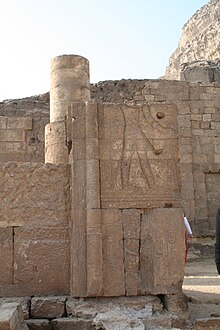Akoris, Egypt
Akoris | |
|---|---|
UTC+2 (EST ) |
Akoris (
Location
Akoris is located on the east bank of the Nile, at and below the
Names of the site

The site was named with several names. In the Old and Middle Kingdoms Mer-nefer(et) (nice channel) was used. In the New Kingdom the site was named Per-Imen-m3t-khent(j) (The house of Amun the foremost lion). In the Late period (from 26th dynasty) it was named T3-dehenet (the cliff top).
In Greek times the names of Ἄκωρις (Akoris or in Latin Acoris) or Τῆνις (Tēnis) were given. The name of Akoris can be found in the third line of the rock stele of Ptolemy V Epiphanes at this site. Akoris is also mentioned by the geographer Ptolemy,[3] and the town appears in the Tabula Peutingeriana.[2]
The Arabic name Tihna (
History

The site was settled since the
Archaeological remains came only from the New Kingdom and earlier times. In the New Kingdom the Temple of Amun was established in a former Old Kingdom tomb by Ramesses II and enlarged by Ramesses III. It is assumed that a fortress was established at this site in Persian times because of the strategic location of the town but no part of the fortress remains.
Akoris became an important town during the Greek and Roman periods, and its name was changed to Akoris. The today's settlement traces came from the Roman and Coptic times.
Monuments
Akoris is home to several archaeological sites, including a number of rock-cut tombs from the
Gods
The gods are related to the site location and shape of the rocks. The earliest goddess of this site is maybe a lion goddess. From the Fraser Tombs the goddess
Mining

Like similar sites in the north and south of Akoris, this site was used as a limestone quarry in ancient times.
Excavations
Records of the site were made during Napoleon's expedition to Egypt. A more comprehensive investigation was made by the German expedition conducted by Karl Richard Lepsius in the 1850s. At the beginning of the 20th century further investigations were made by Ahmed Kamal and Gustave Lefebvre. Since 1981 new comprehensive excavations have been carried out by a Japanese team under H. Kawanishi. They uncovered a fine but fragmentary Middle Kingdom model of a wooden boat. Since 2002, the team has investigated the southern part of the site and uncovered the TIP town.
The so-called
See also
- List of ancient Egyptian sites, including sites of temples
References
- ^ a b Peust, Carsten. "Die Toponyme vorarabischen Ursprungs im modernen Ägypten" (PDF). p. 96.
- ^ a b
 Smith, William, ed. (1854–1857). "Acoris". Dictionary of Greek and Roman Geography. London: John Murray.
Smith, William, ed. (1854–1857). "Acoris". Dictionary of Greek and Roman Geography. London: John Murray.
- ^ Ptolemy. The Geography. Vol. 4.5.59.
Further reading
- Description de l’Égypte, Texte, vol. IV, pp. 372 – 377; Antiquités, vol. IV, plates 67.14–67.20.
- Karl Richard Lepsius, Denkmäler aus Aegypten und Aethiopien, Text vol. II, pp. 50–54; Tafeln Abth. 6, vol. XII, plates 75.15-75.23.
- Ahmed Kamal, Fouilles à Tehneh, in: Annales du Service des Antiquités de l’Égypte, vol. 4 (1903), pp. 232–241.
- Gustave Lefebvre, L. Barry, Rapport sur les fouilles exécutées à Tehnéh en 1903–1904, in: Annales du Service des Antiquités de l’Égypte, vol. 6 (1905), pp. 141–158, 2 plates.
- Labib Habachi, Three Large Rock-Stelae Carved by Ramesses III near Quarries. In: The Journal of the American Research Center in Egypt, ISSN 0065-9991, vol. 11 (1974), pp. 69 – 75, in particular pp. 71 – 73, plates 7 and 10.
- ISBN 951-95073-7-X.
- Dieter Kessler, Historische Topographie der Region zwischen Mallawi und Samaluṭ, Wiesbaden : Reichert, 1981, ISBN 978-3-88226-078-6, pp. 253 – 290.
- Paleological Association of Japan / Egyptian Committee, Akoris : report of the excavations at Akoris in Middle Egypt; 1981–1992, Kyoto, Koyo Shobo, 1995.
- Rosemarie Klemm, Dietrich D. Klemm, Stone and Stone Quarries in Ancient Egypt, London, British Museum Press, 2008, ISBN 978-0-7141-2326-4(Translation from the German Steine und Steinbrüche im alten Ägypten, Berlin, 1993)
- Kawanishi, H., Tsujimura, S. and Hanasaka, T. (eds.) Preliminary Report AKORIS, Tsukuba, University of Tsukuba, 1999-, ISSN 1344-9893
External links
- "Tihna el-Gebel". EgyptSites. 14 February 2009. Retrieved 2009-04-10.
- (in German) "Ṭihnā el-Gebel". Wikivoyage. Retrieved 2023-07-09. Most comprehensive web resource
- Akoris Archive - Official website of Akoris Archaeological Project
